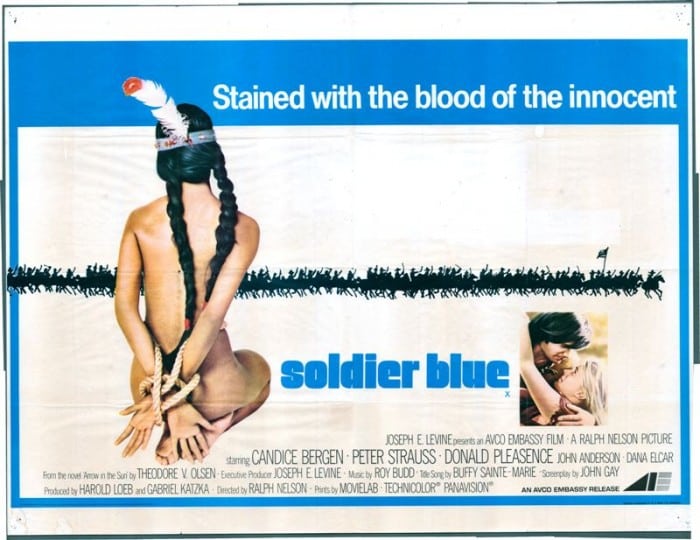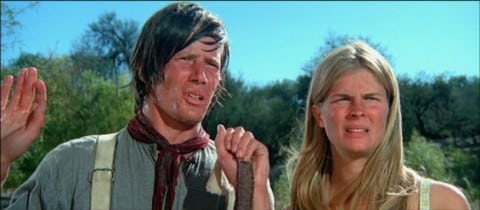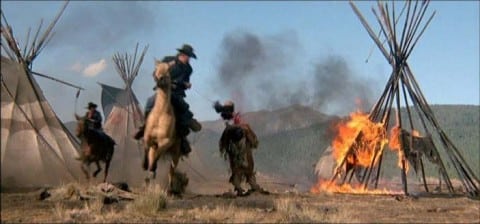Soldier Blue (1970)
Directed by: Ralph Nelson
Written by: John Gay, Theodore V. Olsen
Starring: Candice Bergen, Donald Pleasence, John Anderson, Peter Strauss
HCF REWIND NO.258: SOLDIER BLUE [US 1970]
AVAILABLE ON DVD
RUNNING TIME: 112 min
REVIEWED BY: Dr Lenera, Official HCF Critic
Private Honus Gent is amongst a group of US cavalry making its way to Fort Reunion. Accompanying them is Cresta Lee, a woman journeying to meet her fiancée. They are attacked by Cheyenne Indians and all are killed except for Honus and Cresta, who hide until the Native Americans have gone. The two must try to make it to the fort themselves, but they don’t get on very well because Honus is shocked both by Cresta’s un-ladylike manner, and by her saying that she sympathises with the Indians, people who are fighting for their land and their survival….
When Dances With Wolves came out in 1990, people often went on about how it was the first film that didn’t portray the Native Americans as savages and ‘the enemy’, but there were those of us who would try to draw their attention to earlier films which did the same thing. Even back in the 50’s you had Broken Arrow and Apache, films that I appreciated very much as a young boy who was very much into ‘Cowboys and Indians’ but who was always on the side of the reds, not the whites. 1970 saw three films which were firmly on the side of the Native Americans and which all did big box office: A Man Called Horse [this is the one perhaps the closest to Dances With Wolves], Little Big Man and Soldier Blue. The first two are very impressive movies whether you’re interested in the subject matter or not. Now Soldier Blue….well, it’s an odd picture truth be told and far more divisive than the other two. For much of its running time, it’s a picaresque Two Mules For Sister Sara-type tale of a man and a woman forced to journey together and getting ‘closer’, until its brutal and true-to-life climax which should make any human being feel angry, and one wonders if a different type of story would have been more appropriate, but the film has its pleasures and is full of passion in its defence of the original inhabitants of North America. And, despite the arguments of many ignorant people, it certainly is not exploitation.
Director Ralph Nelson had previously made the very fine, if quite conventional, Cavalry vs. Indians picture Duel At Diablo. John Gay’s screenplay used most of the events of the first half of Theodore V. Olsen’s novel, but then stuck the real-life event of the Sand Creek massacre at the end. Orphaned amputees were used for the climax, the children thinking it was a tremendous joke to run around covered in fake blood having fake arms cut off. Filmed in Mexico, the medium budgeted film, though a commercial success, had a very mixed reaction. It was re-released in 1974 in the US in a ‘PG’-rated version that cut down the climax to mostly reaction shots, a version which I believe was the one that used to be shown decades ago on UK TV as I think it was the one I saw. In UK cinemas, the decapitation of an Indian squaw and a brief rape and breast-slicing were removed, while the video restored the beheading but made further cuts elsewhere. Successive versions restored more and more until now it’s uncut in the UK except for some shots of illegal horse falls. I don’t like watching horses being tripped up, but I’ve never really seen the point of removing shots of it happening from old movies. It’s not as if we can do anything about it.
Soldier Blue is most definitely a film of its time, something evident right from the very beginning when you hear Buffy Sainte-Marie’s title song, full of meaningful, if ‘hippie-ish’ lyrics but rather ruined for me by the wailing manner in which it’s sung [someone like Joan Baez would have done it far better justice in my view]. The film opens with some action and soldiers being attacked and killed by the Cheyenne. Some might say that, in holding back a bit on showing the brutality of the Native Americans compared to the viciousness of the US soldiers at the end, the film becomes one-sided almost immediately, though it’s not something I have a problem with [I guess that sometimes one can’t help one’s political viewpoints inform one’s opinion of certain films even if one generally tries to avoid such things], and it’s still quite violent and bloody and sets the viewer against the Native Americans for a short while until Cresta gives an impassioned speech about how they are having their land being taken away from them and are fighting for their survival.
Of course Honus doesn’t take kindly to Cresta saying this kind of thing, and the movie becomes chiefly two things. It details a man’s awakening to what is really going on around him, and who’s side is actually the ‘right’ side. It’s also an archetypal story of two opposites thrown together who eventually form a connection. Some of the scenes between Honus and the more wordly-wise Cresta are quite funny, like Honus, who has probably never slept near a woman in his life, unable to go to sleep while Cresta is cuddling him for warmth, and some are quite sweet, though the film spends so much time on this stuff that, despite the superb outdoor photography of Robert B. Hauser and some excitement provided by some Kiowa Indians and Donald Pleasance in fine eccentric form as a man selling guns to the Indians, it’s easy to wonder where all this is going. This was the first time I’d seen Soldier Blue in around thirty years, despite apparently more complete TV showings since the 80’s, and I was enjoying its rather relaxing mood. It helps that the performance of Peter Strauss, often full of sadness and horror, is very strong. As for Candice Bergen, she’s okay, though her character seems a bit anachronistic, very much the liberated hippie chick, even if her main role is to spiritually awaken Honus, and a love scene between the two, if well played, doesn’t entirely ring true.
Of course Soldier Blue is primarily known for its climactic depiction of the Sand Creek massacre, one of the most infamous incidents in the history of the American West, in which Colorado Territory militia massacred a village of Cheyenne and Arapaho. Graphic, upsetting, technically still holding up, and profoundly disturbing [even today you don’t many films where children are slaughtered on-screen], and deliberately referencing events like the My Lai massacre in 1968 in the Vietnam War, it’s been called dishonest and a cheap attempt to shock, and I just wonder what the people who say those things are on, though I guess some of it is just down to lack of education or ignorance. This is actually how the west was really won folks, the near-decimation of an entire race, and the event shown in Soldier Blue was not at all an isolate case, while in fact it actually holds back on showing much of the true horror. It doesn’t show women’s private parts being cut out and used as wallets or stretched over the attacker’s hats and saddle-bows, it doesn’t show pregnant women having their embryos cut out, it doesn’t show small children being taken a distance and then being left to starve in the desert. Soldier Blue is an uneven, even awkward film in parts, and isn’t entirely accurate [it makes one especially big boo-boo when it claims the battle of Little Big Horn took place before the film’s events]. Nor does it have the courage to give prominence to any of its Native American characters [and the only one it does give a little to, Cresta’s ex-husband Spotted Wolf, is obviously played by a Mexican] but it deserves to be seen by anyone who still believes the nonsense told in many old Westerns. I admire, for example, John Ford as a filmmaker, but many of his films were the glorification of a lie plain and simple.
Roy Budd’s score backs up the events nicely but knows when to hold back, like in the climax where you usually hear just one long note. One piece heard sometimes is obviously modelled on the intro to the famous theme from The Magnificent Seven, and I even heard a bit of The Wild Bunch a couple of times, but it was Budd’s first film score. I suppose, talking about Soldier Blue, it all comes down to whether you think the first three quarters and the final quarter go together, whether in fact it’s right to precede a recreation of something like the Sand Creek massacre with stuff that’s almost incongruous. In the cause of writing this review, I’ve come to the conclusion that, while the film could have possibly lost a bit of footage here and there, its odd construction doesn’t really weaken its power and perhaps even enhances it. The Sand Creek massacre virtually comes out of the blue, just as it did for those Native Americans who were promised that they would be safe on land that had been ‘given to them’ by the American government [even though it was their’s anyway].







Soldier blue still a brilliant film after all these years although at times shocking. Filmfan
America is still anti the non-White class.
Shame on them.